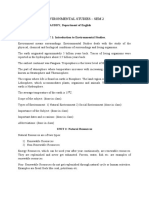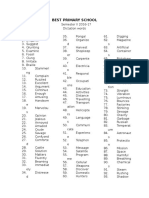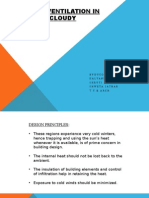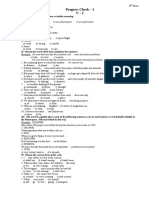Untitled
Untitled
Uploaded by
api-233604231Copyright:
Available Formats
Untitled
Untitled
Uploaded by
api-233604231Copyright
Available Formats
Share this document
Did you find this document useful?
Is this content inappropriate?
Copyright:
Available Formats
Untitled
Untitled
Uploaded by
api-233604231Copyright:
Available Formats
LESSON-1 GUJARAT IN THE MEDIEVAL AGE A-1.
Siddhhem Shabdanushasan was the first grammar book in literature written by Hemchandracharya during the time of Siddhraj Jaysinh.So , it was given a lot of respect by keeping it on the back of an elephant and carrying out a procession in the city. A-2.It is believed that Vanrajs best friend Anhil helped him to regain his fathers lost kingdom.So, he named the new city as Anhilwad Patan. A-3.Queen Minaldevi, mother of Siddhraj Jaysinh always remained ready for the the welfare of the people.So she waived off the pilgrim tax. A-4.The last emperor of the Vaghela dynasty, Karandev Vaghela, was defeated by Alauddin Khilji and it brought an end to the Rajput rule over Anhilwad Patan. Anhilwad Patan remained the capital of Gujarat for namesake for a period of time.The capital was shifted to Ahmedabad when Ahmedshah of Sultanate Age established and Patan became the headquarters of Subagiri(district). EX 2 GIVE AN INTRODUCTION ABOUT 1)ANHILWAD BHARWAD:-He was a shepherd boy and a very good friend of Vanraj Chavda.Patan was renamed as Anhilwad Patan as Anhil helped Vanraj to regain his fathers lost kingdom. 2)MINAL DEVI:-She was the mother of Siddhraj Jaisinh. She always remained ready for the welfare of the people, she waived off the pilgrim tax. 3) HEMCHANDRACHARYA :- The famous scholar Hemchandracharya was well known during the rule of Siddhraj Jaysinh. He prepared and wrote the Grammar book Siddhem Shabdanusashan'. This book was kept on the back of an elephant and a procession was carried out in the city. In this procession, the king and the composer of the book walked along with the entire kingdom.
4) NAIKIDEVI:- After the demise of Ajaypal, his son, was very young for the throne. So his rule was taken over by his wife Naikidevi. AT that time Shahbuddin Ghori crossed the desert and attacked Gujarat. She tied her son on her back and led
the army of Gujarat. She bravely faced the army of Shahbuddin Ghori and defeated him.
5)QUEEN UDAYMATI:- She constructed a step well for the welfare of the people. It is known as Raniki Vav. This step well of seven storeys is unparalleled example of art and architecture. The artistic idols engraved in the well gives the idea of glory of Solanki period.
6) KUMARPAL: Gujarats prosperity was as its peak during the rule of Kumarpal. During his time confluence, non-violence, prosperity and education was seen in Anhilwad Patan. He was the ruler of Solanki dynasty who later renounced the crown and became hermit.
L-2 INDIA : CLIMATE AND NATURAL RESOURCES. EX 1 Write a Shortnote On :1 CLIMATE OF INDIA INTRODUCTION :- India is a vast country in terms of area. Thus the climatic condition is different in different places. 1) India experiences three seasons. They are :a) Summer. b) Winter. c) Monsoon. Summer :- India experiences Summer season between March and may. The temperature is high in regions which are near the Tropic of Cancer. Winter :- India experiences cold between December, January and February. As the suns rays fall slant, there is fall of temperature. Northern and north-eastern part of India experiences mainly Winter season. Many a times snow falls in this region.
a)
b)
c)
2)
Monsoon :- India experiences monsoon from June to September. There is maximum 80 % of rainfall in this season. The winds flowing from the Arabian Sea brings rainfall in Kerala. The winds blowing from Bay Of Bengal brings rain to Assam, Meghalaya and West Bengal. The region of South India is a peninsula. Due to it there is moderate climate in that region. As India is situated between 8 degree north to 37 degree north hemisphere the climate of north India remains cold and middle region experiences heat. NATURAL RESOURCES :1) The things or materials which are stored by human beings and categorized based on its characteristics, power and capacity to work are known as resources. 2) The materials available on Earth naturally, which are easily available and useful to human beings are known as natural resources. 3) There are mainly three types of resources. They are :a) Water Resources. b) Mineral Resources. c) Land Resources. 4) The water resources include rivers, lakes, sea, etc. 5) Biological and Abiological materials which are trapped under the Earth transforms into a particular chemical constitution due to pressure and heat. They are called minerals. 6) Mineral resources are the backbone of the economy of the country. 7) Land resources include forests. 8) The forest provides variety of products. Some are main and the other are secondary products. The forest are beneficial in many ways and so we should stop the deforestation. III Write a short note on Importance of forest and how to conserve it 1)Forest provides us with many primary and secondary products. *IMPORTANCE OF FORESTS
1)Trees of Sundari found in the Sundarban forest are used for making boats and steamers. 2)Artistic things like baskets, mats, toys and furniture are made from cane wood. 3)Brooms are made from the leaves of palm and date trees. 4)Paper and medicines are made from deodar and chid trees. Moreover tea boxes, matchsticks, sports boots, artificial fibres are also made from these trees. 5)Trees also provide lac for making varnish, ink for Printing, paper of making speakers of electronic goods and gramophones, etc. *MEASURES TO CONSERVE FOREST 6)Illegal cutting of trees should be prohibited. 7)Trees should be grown on wasteland and people should be motivated for afforestation. 8)Use of renewable resources such as solar energy, biogas, wind energy, etc. should be increased. 9)An atmosphere which encourages every citizen to be responsible for protecting forests should be created. ANSWER THE FOLLOWING Q-1.Why are the rivers of South India not useful as waterways? A-1.The rivers of South India like the Godavari, the Kaveri and the Tungabhadra flow towards the east and then into the Bay of Bengal. These rivers flow from uneven plains and therefore form waterfalls. That is why these rivers are not used as waterways. Q-2.How does climate affect the human life? A-2.Effects of climate on human life : 1 Climate effects diet , life style and behaviour of people. 2 For example people living in dry regions like Rajasthan have flat terraces on their houses for storing water during rains 3 People of north India wear woolen clothes to protect themselves from chilling cold.
4 People of south India prefer cotton clothes to protect themselves from heat and to blow off the dust . 5 Due to favourable condition in north India farming is seen more in this region 6 Due to different climatic condition Gujarat grows wheat where as Tamil Nadu , Kerala and West Bengal grow rice 7 Marine industry has developed in regions having coast line Q.3 What are resources ? Explain. A.3 Things or materials such as land , wildlife , minerals , sea etc that exists in a region and can be utilized for fullfilling requirements of humans are called resources 1 Man categories these resources on the basis of their characteristics and utility 2 In ancient times people could not make use of these resources in large proportion where as the modern man learnt to make maximum use of them to satisfy his needs and for his welfare. Q.4 What you mean by climate and climatic condition?Which factors affect the climate? A-4.1)Climate is a weather condition that exists in an area in a particular time every year. 2)Conditions related to climate or weather are called as climatic conditions. 3)Several factors such as location of the country, height of its landmass, mountains, plateaus, distance from the sea, flow of the sea, forest, etc. affects the climate. Q-5.Show details of the following in the political map of India. a)Two places of excessive rainfall *Meghalaya and Malabar coast b)Two places of scanty rainfall *Rajasthan and Gujarat c)Two places of moderate rainfall *Maharashtra and Gujarat Q-6.Show the following details in the political map of India.
a)Rajasthan b)River Narmada c)Chilka Lake d)Bear Sanctuary e)A place where mineral oil is found f)Tropic of Cancer LESSON-3 WHY ARE COURTS NECESSARY EX 1 SHORT NOTE 1)HIGH COURT 1.Every state has a high court. 2.High court is above all the courts of the state. 3.The High Court of Gujarat is in Ahmedabad. 4.The jurisdiction of each high court is within its state. 5.All the High Courts of every state are at the same level. 6.High Courts are also called as Court of Records. 7.Over and above the main judge there are additional judges to help the main judge in taking a decision. 8.Anyone can file a case in the High Court. However if the court feels that a wrong appeal is being made by a person filing a case, then it can also punish the one who has made a wrong appeal. 9.The High Court Judge takes his oath before the Governor. EX 2 ANSWER THE FOLLOWING Q-1.Why are courts necessary? A-1.*Courts listen to the cases brought to them. *Based on the arguments, evidences and witness the court provides justice to the victims. *Thus the courts are necessary to maintain faith, peace and security in the society.
You might also like
- Stat 331 Course NotesDocument79 pagesStat 331 Course NotesthemanzamanNo ratings yet
- F.H. Schweingruber Tree Rings. Basics and Applications of DendrochronologyDocument289 pagesF.H. Schweingruber Tree Rings. Basics and Applications of DendrochronologyLuis David Huayta100% (1)
- SS 1 2ND Term Geography NotesDocument19 pagesSS 1 2ND Term Geography NotesSochi100% (2)
- Maths AssignmentDocument6 pagesMaths AssignmentKaison LauNo ratings yet
- UntitledDocument13 pagesUntitledapi-233604231No ratings yet
- gala ss 6Document44 pagesgala ss 6PREM PARESHKUMAR DIWANNo ratings yet
- Water SecurityDocument35 pagesWater Securitysurekhatelang1No ratings yet
- 6th GEOGRAPHY WORKSHEET AnswersDocument4 pages6th GEOGRAPHY WORKSHEET AnswersopeliacorpseNo ratings yet
- Environment Law ProjectDocument22 pagesEnvironment Law ProjectUday ReddyNo ratings yet
- gala ss 3Document36 pagesgala ss 3PREM PARESHKUMAR DIWANNo ratings yet
- IGNOUDocument17 pagesIGNOUutp3196No ratings yet
- Assertion and Reasoning Class 8 Social ScieneDocument11 pagesAssertion and Reasoning Class 8 Social Scienes_sawhneyNo ratings yet
- Class 11 1 Chapter Geography Important Questions 1Document4 pagesClass 11 1 Chapter Geography Important Questions 1Abhishikta DasNo ratings yet
- SST c-6 Quarterly SolutionDocument7 pagesSST c-6 Quarterly SolutionsahajbihatNo ratings yet
- Soc - Science - Lesson 2 SolutionDocument2 pagesSoc - Science - Lesson 2 SolutionBashir Ahmad EsarNo ratings yet
- History ProDocument21 pagesHistory ProAngela JohnNo ratings yet
- Class 4 Social Studies Sa I Revision Term 1Document5 pagesClass 4 Social Studies Sa I Revision Term 1mohammedowais8143No ratings yet
- QAGeographyDocument5 pagesQAGeographymalanupamNo ratings yet
- Class V Jan Hist, Geo, Lit, Science, BGSDocument8 pagesClass V Jan Hist, Geo, Lit, Science, BGSSN1 RoyalNo ratings yet
- Ii. Fill in The BlanksDocument24 pagesIi. Fill in The BlanksSourav RahaNo ratings yet
- P B N D: Relim Ooster Ews IscussionDocument31 pagesP B N D: Relim Ooster Ews Iscussiongaurow guptaNo ratings yet
- Summative Assessment - 1: (Answers)Document5 pagesSummative Assessment - 1: (Answers)Sanchit MukherjeeNo ratings yet
- Orient BlackswanDocument3 pagesOrient BlackswansaritabastianNo ratings yet
- Your World Your Commonwealth Worksheet and A Taste of IndiaDocument2 pagesYour World Your Commonwealth Worksheet and A Taste of IndiaAdriaDiazNo ratings yet
- History Our Past-IDocument15 pagesHistory Our Past-IshashankniecNo ratings yet
- SST NotesDocument7 pagesSST NotesDeepak KumarNo ratings yet
- Andaman and Nicobar IslandsDocument11 pagesAndaman and Nicobar Islandssrp4683No ratings yet
- History Ncert Vi Class (Key Points) : Neolithic Sites Megalithic SitesDocument9 pagesHistory Ncert Vi Class (Key Points) : Neolithic Sites Megalithic SitesPiyush agrawalNo ratings yet
- Belgharia Jatindas Vidyamandir: Sub: History Class: V1 Chap: Economy and Society (Chap 7) A. MCQDocument9 pagesBelgharia Jatindas Vidyamandir: Sub: History Class: V1 Chap: Economy and Society (Chap 7) A. MCQyasminfirdous5No ratings yet
- SSTDocument5 pagesSSTkingX GamingNo ratings yet
- Class IX: Chapter 3 - Drainage (Question & Answers) : Economic Benefits of RiversDocument3 pagesClass IX: Chapter 3 - Drainage (Question & Answers) : Economic Benefits of Riversatul ratan100% (2)
- Ix Social Science 18-05-2023Document9 pagesIx Social Science 18-05-2023jitendersumitaNo ratings yet
- PUC II History Question SolveDocument117 pagesPUC II History Question Solveಶಾಂತಾ ಸ ಮೀಶಿNo ratings yet
- Class IX Geog ch-3 PDFDocument3 pagesClass IX Geog ch-3 PDFatul ratanNo ratings yet
- Ecological History of India". by Irfan Habib. Aligarh HistoriansDocument3 pagesEcological History of India". by Irfan Habib. Aligarh HistoriansIjahss JournalNo ratings yet
- Ckass 7Document4 pagesCkass 7jikooNo ratings yet
- TISS Notes Part 2 - GKmojoDocument19 pagesTISS Notes Part 2 - GKmojoyash11.radheNo ratings yet
- Natural Vegetation and Wildlife - NotesDocument3 pagesNatural Vegetation and Wildlife - NotesPrithik Chand ArunNo ratings yet
- 3 Manipur - Folk SongDocument25 pages3 Manipur - Folk Songbikramjit48100% (1)
- IJPUB1802020Document4 pagesIJPUB1802020Imran Afzal BhatNo ratings yet
- General KnowledgeDocument26 pagesGeneral KnowledgeadmissionNo ratings yet
- Date 18th March 2019 State Tamil NaduDocument21 pagesDate 18th March 2019 State Tamil Nadukash asdfNo ratings yet
- Forest Societies and ColonialismDocument18 pagesForest Societies and ColonialismNilesh KumarNo ratings yet
- Resources and DevelopmentnDocument5 pagesResources and DevelopmentnRudra Pratap Verma 8CNo ratings yet
- Ba - Ll.b. (Hons.)Document13 pagesBa - Ll.b. (Hons.)nitishNo ratings yet
- What, Where, How and WhenDocument8 pagesWhat, Where, How and Whenanurag.chouguleNo ratings yet
- Ecology of UPDocument33 pagesEcology of UPsinghyashwant102No ratings yet
- FG PDFDocument111 pagesFG PDFMarthala Venkata Ravi Teja ReddyNo ratings yet
- Indian GeographyDocument6 pagesIndian Geography07gmalik07No ratings yet
- General KnowlegeDocument42 pagesGeneral Knowlegepkd_iertNo ratings yet
- G.K & Current Affairs - Reference Sheet Mind Faces Entrance ProgramDocument19 pagesG.K & Current Affairs - Reference Sheet Mind Faces Entrance Programaashi shahNo ratings yet
- Readiness - Class 10 - Systems & SocietiesDocument6 pagesReadiness - Class 10 - Systems & SocietiesDeadlyNo ratings yet
- Know India BookletDocument31 pagesKnow India BookletPrashantpal RaiNo ratings yet
- Geo - 1Document5 pagesGeo - 1shanmugarajganeshanNo ratings yet
- Environmental Studies - Sem 2Document3 pagesEnvironmental Studies - Sem 2studio aponNo ratings yet
- Digi Magazine - YouthestaDocument56 pagesDigi Magazine - YouthestaShanmugan PalanisamyNo ratings yet
- Natural Resources - Water and Forest WealthDocument53 pagesNatural Resources - Water and Forest WealthJatin SharmaNo ratings yet
- Unit 1: Water Education: Environment and EcosystemDocument20 pagesUnit 1: Water Education: Environment and Ecosystemgyou6420No ratings yet
- 11th May Mains Model AnswersDocument11 pages11th May Mains Model Answersfareastauto2019No ratings yet
- G H 1 2 3 - CompressedDocument94 pagesG H 1 2 3 - CompressednyilatlNo ratings yet
- Glories of Ancient India-QuotesDocument98 pagesGlories of Ancient India-QuotesinboxpradeepNo ratings yet
- UntitledDocument9 pagesUntitledapi-233604231No ratings yet
- 25ff6 b2d8Document16 pages25ff6 b2d8api-233604231No ratings yet
- 25f8e d64fDocument6 pages25f8e d64fapi-233604231No ratings yet
- Sem - II STD-III English General Assignment - 2017 Paper StyleDocument11 pagesSem - II STD-III English General Assignment - 2017 Paper Styleapi-233604231100% (1)
- 25fdc 3c9eDocument4 pages25fdc 3c9eapi-233604231No ratings yet
- 25f08 1f92Document7 pages25f08 1f92api-233604231No ratings yet
- Best Primary School Std.:-I Second Semester Assignment Sub: Science Course - Lesson No:6,8,10,11,12,13,15. Paper Style (60 Marks)Document7 pagesBest Primary School Std.:-I Second Semester Assignment Sub: Science Course - Lesson No:6,8,10,11,12,13,15. Paper Style (60 Marks)api-233604231No ratings yet
- 25f8c 3757Document8 pages25f8c 3757api-233604231No ratings yet
- 25f85 99beDocument20 pages25f85 99beapi-233604231100% (1)
- 25f06 Ce2dDocument13 pages25f06 Ce2dapi-233604231No ratings yet
- Best Primary School STD:-2 Sub:-Grammar (S.A.-2 Assignment) MARKS:-60 Ex.1 Tick The Correct Words in The BracketDocument8 pagesBest Primary School STD:-2 Sub:-Grammar (S.A.-2 Assignment) MARKS:-60 Ex.1 Tick The Correct Words in The Bracketapi-233604231No ratings yet
- STD 7 SA2 Eng. Gr-2017 Ex 1 Join With Conjunctions: VII Grammar 1Document7 pagesSTD 7 SA2 Eng. Gr-2017 Ex 1 Join With Conjunctions: VII Grammar 1api-233604231No ratings yet
- VIII Grammar 1Document10 pagesVIII Grammar 1api-233604231No ratings yet
- 25ee4 34b7Document7 pages25ee4 34b7api-233604231No ratings yet
- 1 STD Eng-Gram 2 Semester: ST STDocument6 pages1 STD Eng-Gram 2 Semester: ST STapi-233604231No ratings yet
- 25ee1 3042Document4 pages25ee1 3042api-2336042310% (1)
- 25eaa 740fDocument8 pages25eaa 740fapi-233604231No ratings yet
- 25eae 9228Document8 pages25eae 9228api-233604231No ratings yet
- 25edb A6d9Document22 pages25edb A6d9api-233604231100% (1)
- 25eff E973Document9 pages25eff E973api-233604231No ratings yet
- 25ee2 86aeDocument7 pages25ee2 86aeapi-233604231No ratings yet
- 25eab d022Document11 pages25eab d022api-233604231No ratings yet
- 25ea9 E51cDocument10 pages25ea9 E51capi-233604231No ratings yet
- 25ea8 8093Document9 pages25ea8 8093api-233604231100% (1)
- 25e9e 1bf1Document8 pages25e9e 1bf1api-233604231No ratings yet
- 25e97 7578Document7 pages25e97 7578api-233604231100% (1)
- 25ea4 90edDocument3 pages25ea4 90edapi-233604231No ratings yet
- Best Primary SchoolDocument2 pagesBest Primary Schoolapi-233604231No ratings yet
- MATERI KULIAH Ekologi Tanaman 2011Document134 pagesMATERI KULIAH Ekologi Tanaman 2011Elsa Ade Komala100% (1)
- Speech Delivered by Senator Lorren Legarda For Liga NG Mga BarangayDocument3 pagesSpeech Delivered by Senator Lorren Legarda For Liga NG Mga BarangayjoreyvilNo ratings yet
- STS Module 11 - Climate ChangeDocument8 pagesSTS Module 11 - Climate ChangeHanna Jane CalanugaNo ratings yet
- Natural Ventilation in Cold and Cloudy Climate.: Bvducoa, Pune. Kalyani Jaiswal Shruti Dhariya Shweta Jathar T.Y.B.ArchDocument21 pagesNatural Ventilation in Cold and Cloudy Climate.: Bvducoa, Pune. Kalyani Jaiswal Shruti Dhariya Shweta Jathar T.Y.B.Archkalyani jaiswalNo ratings yet
- Mount Everest A Case Study Harvard and IIM AhmedabadDocument5 pagesMount Everest A Case Study Harvard and IIM AhmedabadSupratim BhattacharyaNo ratings yet
- Homonym Words ListDocument9 pagesHomonym Words ListMarie Antonette Aco BarbaNo ratings yet
- Motorbike PDFDocument30 pagesMotorbike PDFmNo ratings yet
- Eagle 0526 A 11Document1 pageEagle 0526 A 11Jonathan ResendezNo ratings yet
- Blend Phonics ReaderDocument42 pagesBlend Phonics ReaderNazirah Alan50% (2)
- Wind Analysis of TowerDocument5 pagesWind Analysis of Towerar4indNo ratings yet
- Cheat Codes GTA VDocument3 pagesCheat Codes GTA VDelfi PebryanNo ratings yet
- Listening: Climate ChangeDocument4 pagesListening: Climate ChangeMai Anh LêNo ratings yet
- Emotive Language (Exercises)Document2 pagesEmotive Language (Exercises)Yoon NadiNo ratings yet
- Korean PhraseBookDocument75 pagesKorean PhraseBookJonathan Arley Torres CastañedaNo ratings yet
- William Shakespeare Emily Dickinson Information and 2 Poems EachDocument3 pagesWilliam Shakespeare Emily Dickinson Information and 2 Poems EachJasvinder SinghNo ratings yet
- Enjoy English 8. TestDocument2 pagesEnjoy English 8. TestharoldpsbNo ratings yet
- Crri Colas Project PDFDocument120 pagesCrri Colas Project PDFSunil BoseNo ratings yet
- Verb Patterns Tricky OnesDocument4 pagesVerb Patterns Tricky OnesFran YoNo ratings yet
- lr-60xr r2Document30 pageslr-60xr r2fierrohalcon100% (1)
- Competencies For Meteorologists & Meteorological TechniciansDocument47 pagesCompetencies For Meteorologists & Meteorological TechnicianspanNo ratings yet
- Dialogues in PairsDocument7 pagesDialogues in Pairszhu fengyue100% (1)
- Writing Narratives ORIGINALDocument66 pagesWriting Narratives ORIGINALRhoda SanchezNo ratings yet
- Unit Introduction: Flashcards (1 Hour) : Theme: Time AllocatedDocument20 pagesUnit Introduction: Flashcards (1 Hour) : Theme: Time AllocatedAmira selmaneNo ratings yet
- A2 - End of Course Test - With KeyDocument14 pagesA2 - End of Course Test - With KeynevenkaNo ratings yet
- The Tempest I & IIDocument3 pagesThe Tempest I & IIAqib NissarNo ratings yet
- SA3 TRP p.81 95 StudentsDocument12 pagesSA3 TRP p.81 95 StudentsKatia PipiliNo ratings yet
- Answer Key For Students' Book and Work BookDocument4 pagesAnswer Key For Students' Book and Work BookFarras ShidqiNo ratings yet





















































































































